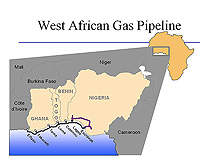
West African Gas Pipeline (WAGP) is a 421-mile long regional high-pressure gas transmission system, built to export Niger Delta gas from the Lagos Beach terminal in Nigeria to Ghana, via Benin and Togo. The WAGP is the first such pipeline to be installed in sub-Saharan Africa. It is also one of the largest fossil fuel projects undertaken in Africa.
The pipeline is owned and operated by the West African Gas Pipeline Company (WAGPCo). It is led by Chevron with a working interest of 36.7%. Nigerian National Petroleum is the second largest shareholder with a 25% working interest. Shell Overseas Holdings and Takoradi Power respectively have 18% and 16.3% shares in the company. The remaining four percent interest in the project is owned by Societe Togolaise de Gaz (two percent) and Societe BenGaz (two percent).
The pipeline was completed at a cost of $900m, approximately $310m (or 52%) more than the originally estimated cost. It was put into commercial operation in March 2011. It has an initial capacity of 200 million cubic feet of gas a day (mcfd), which is expandable to 600mcfd.
Viability of West African gas exportation system from Nigeria to Ghana
Inception of the West African gas export system dates back to 1982 when its development was proposed by the Economic Community of West African States (ECOWAS). The proposal was strengthened further in 1991 when a feasibility report, sponsored by the World Bank, held that such a project was commercially viable.
Governments of Nigeria, Benin, Togo and Ghana signed a Heads of Agreement in 1995 and undertook the feasibility study for the project in 1999.
A Memorandum of Understanding (MoU) was signed by the participating countries in the second half of 1999 and an Inter-Governmental Agreement was signed in early 2000. The project implementation agreement was signed in 2003.
Financiers backing Africa’s gas pipeline project
The WAGP project was initially estimated to cost $700m, including $l10m for compression costs for 20 years. In November 2004, the World Bank approved two guarantees worth a total of $125m for the construction of the project. These two guarantees included $50m and $75m from the World Bank’s International Development Association (IDA) and Multilateral Investment Guarantee Agency (MIGA) respectively.
In December 2006, a $98m loan was approved by the European Investment Bank (EIB). United States Agency for International Development (USAID) and Overseas Private Investment Corporation (OPIC) also supported the project by providing $1.6m and $45m respectively.
West African Gas Pipeline details and system construction
The WAGP scheme involved installation of a 354-mile offshore pipeline, construction of a 67-mile onshore pipeline, construction of four gas receiving points and then connecting them with the regulating and metering stations at Cotonou (Benin), Lome (Togo) and Tema and Takoradi (Ghana).
Another important component of the project was the construction of the Lagos Beach Compression Station in Nigeria.
The WAGP project broke ground in December 2004 and construction on the project was started in June 2005. Construction of the offshore pipeline was commenced in August 2005.
Onshore civil construction in Nigeria and Ghana was commenced in March 2006, followed by Togo and Benin in August and September 2007 respectively. Construction of the compressor station in Nigeria commenced in April 2006.
The onshore and offshore pipelines were commissioned in April 2008. First natural gas from Nigeria to Ghana was supplied in December 2008.
WAGP route through countries of sub-Saharan Africa
The 35-mile onshore segment of the pipeline in Nigeria provides a connection between the existing Escravos-Lagos Pipeline (EPL) and the newly built Lagos Beach Compression Station. The 354-mile offshore segment of the pipeline runs west from there, through the waters of Benin and Togo before ending at Takoradi in Ghana.
The gas from the main line is delivered to the three countries through gas delivery laterals provided at Cotonou (Benin), Lome (Togo) and Tema (Ghana).
The diameter of the onshore pipeline is 0.76m and that of the offshore pipeline is 0.5m.
Contractors involved with the West African Gas Pipeline project
Engineering, procurement and construction (EPC) contract for the onshore pipeline and facilities of the WAGP was awarded to Willbros in December 2004.
Concrete weight coating for the offshore pipeline was supplied by Bredero Shaw. The contract to build the compressor station at Lagos Beach in Nigeria was awarded to the French contractor Entrepose in July 2008.
Front-end engineering design and drafting services associated with the offshore segment of the project were provided by Project Consulting Services. The offshore pipeline from Lagos to Takoradi was installed by Horizon Marine Construction.

